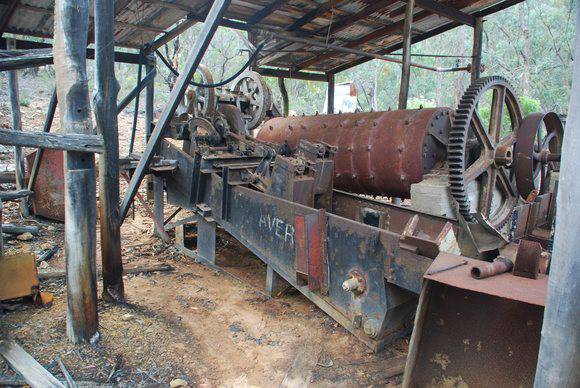| Back to search results » | Back to search page » |
|
MOUNT HEPBURN COMPANY GOLD TREATMENT WORKS
Other NamesGENERAL EXPLORATION COMPANY , KING CASSILIS MINE LocationCASSILIS ROAD TONGIO, EAST GIPPSLAND SHIRE
File NumberHER/2001/000481LevelRegistered |
|
Statement of Significance
What is significant?
The Mount Hepburn Treatment Works is located near the junction
ofPower'sGully and Swifts Creek. It is the site of major
miningoperations from1896 to 1907 and the elaborate plant and
processesrequired to extractgold from refractory ore (heavily
mineralised goldbearing rock). Themine was also briefly worked in the
1930s and 1940s.It is a complicatedand extensive site with a series of
adit levels,tramways and hut sitesand a palimpsest of ore processing
relics on thebank of Swifts Creek.The significant components include but
are notlimited to:
* stone piersvat foundations and discharge tramway.
* Dumps of cyanided and calcined battery sands and pond.
* Bed of large reverberatory furnace, remnants of flue, stack
baseandother structures.
* Large ash dump containing ceramic and iron artefacts.
* Water-jacket blast furnace and small dump of slag.
* Clusters of scrap mining plant and vehicles.
* Barrel furnace, compressor, motor engine and associated
material(slagand flint stones)
* Abandoned huts and sheds.
* Insitu stone crusher, milling machinery and associated structures.
* Earthworks including lower-most mullock heap, tramway andcutting,water
race and concrete reservoir.
How is it significant?
The Mount Hepburn Treatment Works is of historical
andscientificsignificance to the State of Victoria.
Why is it significant?
The Mount Hepburn Treatment Works is historically important as
arareexample of a once widespread type. In the 1870s Victorian
minersbeganto have success in extracting gold from refractory ores
throughaprocess which involved roasting finely ground ore
inreverberatoryfurnaces. In the late 1890s a new chemical process
wasadded to theminer?s ore-retrieval repertoire which involved
usingsolutions ofcyanide. The cyanide process proved to be
extremelyimportant technologyand is still the basis of gold recovery in
themining industry today.Example of both processes ? roasting and
cyaniding- occurs at the siteand their importance at the time is
clearlyillustrated by the scale ofthe surviving heritage.
The Mount Hepburn Treatment Works is scientifically important
forthesurvival of a range of relics documenting attempts to
treatrefractoryores through chemical and metallurgical means. Of
crucialsignificanceis the remains of the cyanide works, the surviving
featuresranging fromvery visible masonry structures to subtle traces. No
otherplace inVictoria or possibly Australia can match the site, in
extent,variety,archaeological or scientific potential in terms of
surviving relics.
Group
Mining and Mineral Processing
Category
Gold Mining Site







